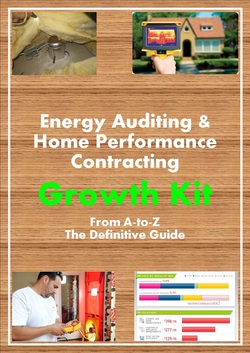Passing the BPI Exam With Energy Auditor Training
FREE BPI PRACTICE EXAMPUT YOUR HOME PERFORMANCE BUSINESS ON ROCKET FUELENERGY AUDITOR NEWSLETTERGet the only Energy Auditor Marketing Newsletter with monthly strategies and tactics to grow your home performance business.
|
BPI Written Exam - Section 1 Building Science Fundamentals2. Understand equipment efficiencies: AFUE, SSE, SEER, EER, HSPF
Quick Terms:
Efficiency is always measured as output / input. For all the efficiency types below, always remember it is only the output / input... how much energy is used over how much energy is put in.
Terms in depth:
1. AFUE - annual fuel utilization efficiency. The Federal Trade Commission requires new furnaces or boilers to display their AFUE so consumers can compare heating efficiencies of various models. Given in percentages, this number tells you how much of your fuel is used to heat your home and how much fuel is wasted. AFUE is a measure of how efficient the appliance is in converting the energy in its fuel to heat over the course of a typical year. An AFUE of 90% means that 90% of the energy in the fuel becomes heat for the home and the other 10% escapes up the chimney and elsewhere. Atmospheric-draft furnaces have AFUE's of 65%. Fan-assisted furnaces have AFUE's of 85% and above. AFUE doesn't include the heat losses of the duct system or piping, which can be as much as 35% of the energy for output of the furnace when ducts are located in the attic. AFUE and distribution are the two best indicators of a heating system's efficiency. You can identify and compare a system's efficiency by not only its AFUE but also by its equipment features. Old, low-efficiency heating systems:
Source: http://energy.gov/energysaver/articles/furnaces-and-boilers 2. SSE - Steady State Efficiency aka combustion efficiency. It is the percentage of heat captured by the heating medium. Accounts for chimney and fuel-burning losses. It can be measured using CO2 or O2 sensing devices. CO2 means that complete combustion is occuring in the heating unit (yaa!), so the greater the CO2 percentage, the greater the SSE. O2 means that there is an excess of air, and thus higher O2 means lower SSE. CO2 and O2 values vary from 3%-13%.
3. SEER - Seasonal Energy Efficiency Ratio. All central air conditioners are required to have an Energy Guide label listing the SEER or EER of the system until it is sold. Most of the time, I have seen the SEER listed, which is the unit's efficiency rating during the cooling season, hence seasonal. The higher the SEER, the higher its efficiency and lower the operating costs in general. A high efficiency unit does not automatically mean lower utility bills, especially if there is high duct leakage or static pressure, there may be no reduction in bills at all. In 2006, SEER 13 became the minimum standard for central air conditioners. Previous standard was SEER 10.
4. EER - Energy Efficiency Ratio. EER is the measure of how many BTU's per hour are used for each watt of power it draws for air conditioners. EER is synonymous with COP (Coefficient of Performance) if you come from an engineering background. In cooling dominated climates with little moisture (Phoenix) EER is more important to performance than SEER. Why, because the EER rating is measured at 95 degrees, which is closer to actual conditions in Phoenix.
5. HSPF - Heating Seasonal Performance Factor. HSPF is the measurement used to gauge the heating efficiency of heat pumps. (A heat pump’s cooling efficiency is measured by its SEER). The HSPF is a heat pump's estimated seasonal heating output
in BTUs divided by the amount of energy that it consumes in watt-hours. Common HSPF ratings are between 8-10.
Next Section
1b. Principals of energy, air & moisture
1c. Combustion science
|
The main topics of the BPI BA exam are listed out below. Click on a link that interests you, or you need some brushing up on to learn more on each subject.
1. Building Science Fundamentals 1a. Basic terms and definitions 1b. Principals of energy, air & moisture 1c. Combustion science 2. Buildings and Their Systems 2a. Building components 2b. Conservation strategies 2c. Comprehensive building assessment process 2d. Design considerations 3. Measurement and Verification of Building Performance 3a. Applied diagnostics and troubleshooting 4. BPI National Standards and Project Specifications 4a. Comprehensive building assessment 5. Analyzing Buildings Systems 5a. Comprehensive building assessment 5b. Appliances and lighting 6. Conduct and communications 6a. Conservation strategies |

